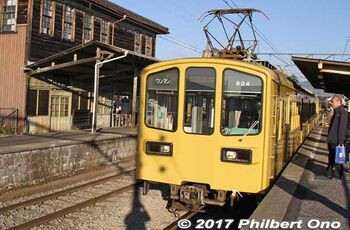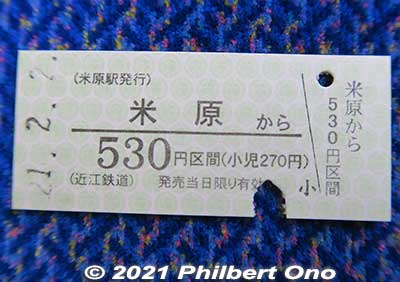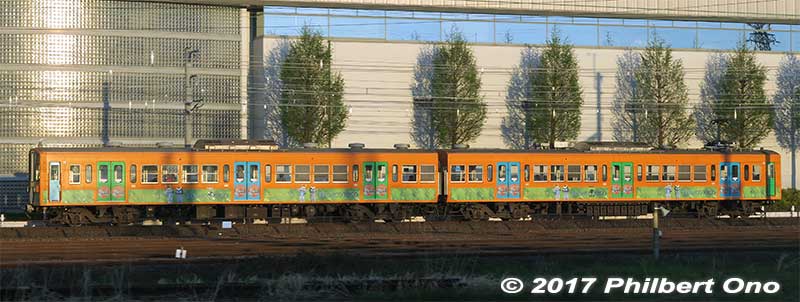Ohmi Railways
| Ohmi Railway (近江鉄道; Ohmi (also Omi, Oumi) Tetsudo) | ||

| ||
| Location | Shiga Prefecture(s) | |
| Terminal Stations | Maibara Station, Omi-Hachiman Station, Yokaichi Station, Kibukawa Station | |
| Major Stations | Maibara Station, Yokaichi Station, Omi-Hachiman Station, Kibukawa Station | |
| Train Types | Futsu only | |
| Train Schedule | Ohmi Railways | |
| Total Distance | Main Line 47.7 km, Yokaichi Line 9.3 km, Taga Line 2.5 km | |
| Opened | Main Line first opened in 1898 and completed in 1931. Yokaichi Line opened in 1913. Taga Line opened in 1914. | |
| Operator | Ohmi Railway Corporation | |
| Others | Other Railways in Shiga, Railways in Japan | |
| Links | ||
Updated: Feb. 14, 2022
Ohmi Railway Corporation (Ohmi Tetsudo 近江鉄道) (sometimes spelled Omi or Oumi) is a private railway company (subsidiary of Seibu Railway based in Saitama Prefecture) operating a few train lines and bus routes in the interior area of eastern Shiga Prefecture, namely Maibara, Hikone, Higashi-Omi, Hino, and Koka.
The trains are short, usually only two or three cars, and they run on single tracks. Since Ohmi Railways belong to the Seibu Group, it uses old cars from Seibu Railway in Tokyo. Train cars are normally yellow like on the Seibu Lines, but some cars have colorful and cute custom liveries for Ohmi Railways. Travel time is quite slow. All the trains stop at every station. No express trains.
Most Ohmi Railway stations have no staff. Tickets are instead collected by the train driver if you get off at a station where there is no staff. Only the following terminal stations are always staffed: Maibara, Hikone, Omi-Hachiman, Yokaichi, and Kibukawa. If there is no ticket vending machine at the station where you board the train, take a numbered ticket when you board the train and show it to the train driver when you get off. He can then tell you how much to pay.
The train line is nicknamed "Gachakon" (ガチャコン) which refers to the banging sound it makes on the rails. Ohmi Railway official Website
On Fri., Sat., Sun., and national holidays (except Dec. 31-Jan. 3), the "One Day Smile Ticket" is available for only ¥900 for adults (¥450 for kids) and you can use it to ride the Ohmi Railways all day. A good deal if you plan to ride the Ohmi Railways train at least twice. Showing the ticket to temples and museums along the Ohmi Railways will also give you a discount on the admission. (Details in Japanese here.)
If you plan to also ride the Shigaraki Kogen Railway on a weekend or national holiday, you should buy the Biwako Keihan-nasen Free ticket (びわこ京阪奈線フリーきっぷ) for unlimited rides on both Ohmi Railways and Shigaraki. Details here.)
Also, during 9 am - 4 pm, you can bring your bicycle aboard the train at most Ohmi Railways stations except Hikone, Minakuchi Ishibashi, and station from Omi-Hachiman to Shin-Yokaichi. (Details here.)
For residents, there are more discounts available. If you have a commuter's pass, you can travel beyond your commuter's pass on Ohmi Railways on weekends and national holidays for only ¥100. (Details here.)
Ohmi Railways also operate buses (Ohmi Tetsudo Bus and Kokoku Bus) from the larger JR and Ohmi Railway train stations. Most of the buses have the Seibu lion mascot.
There are three Ohmi Railway train lines:
- The Main Line (Honsen) is the longest, passing through Maibara, Hikone, Higashi Omi (Yokaichi), Hino-cho, and Koka.
- The short Taga Line (Taga-sen) is for people wanting to worship at Taga Taisha Shrine.
- The Yokaichi Line (Yokaichi-sen) connects Yokaichi with Omi-Hachiman Station. The terminal stations are Maibara, Omi-Hachiman, Yokaichi, and Kibukawa.
History
Ohmi Railways was founded in 1896 because the forerunner of the Tokaido Line which started running in Shiga in 1889 and the now-defunct Kansai Railway running between Kusatsu and Yokkaichi (Mie) never came close to the interior part of eastern Shiga. Ohmi Railways has a close historical connection to Hikone and Hino. The group of 44 people who founded Ohmi Railways Co. consisted of former Hikone samurai and Hino merchants. The first president of Ohmi Railways was a former samurai (Ohigashi Gitetsu 大東義徹) from Hikone, and the second president (Shono Genzo 正野玄三) was a Hino merchant (drug maker).
Ohmi Railway's first rail segment opened in June 1898 between Hikone and Echigawa Stations (12.1 km) on the Main Line. A month later, the line was extended to Yokaichi. The line was extended to Kibukawa Station by Dec. 1900. The Taga Line opened between Takamiya and Taga in March 1914. The segment between Hikone and Maibara opened in March 1931. The electrification of train lines started in March 1925 between Hikone and Taga.
In May 1943, Ohmi Railways becomes part of the Seibu Group with Hakone Tochi (Prince Hotels) taking over business operations. In March 1944, Ohmi Railways merge with Yokaichi Railway which operated the train line between Omi-Hachiman and Shin-Yokaichi Stations. The Yokaichi Line is extended to Yokaichi Station and electrified in Jan. 1946.
Eastern Shiga was and still is a rural area, and Ohmi Railways has struggled financially almost from the beginning. It still operates in the red annually and receives subsidies from local governments in eastern Shiga. The company has been racking its brains on how to get more passengers. It has not been very successful.
In 2019, meetings between the company and local governments were held to decide the fate of the railway. They even compared the costs of converting the railways into bus routes. In the end, they decided to keep Ohmi Railways operating with subsidies from Shiga Prefecture and the five cities and five towns along Ohmi Railway lines. From fiscal 2024, Ohmi Railways will continue to be operated by the private company while being financially supported (¥600–¥700 million per year) by the local governments.
Interesting that the company name of "Ohmi Railway" (近江鉄道株式会社) has remained the same since its establishment in 1896. Although the company's ownership has changed twice (currently a subsidiary of Seibu Railways), the company name has remained the same. Only three railway companies in Japan established during the Meiji Period (1868–1912) have retained their original company name. The other two is Tobu Railway Co. in Tokyo and Shimabara Railroad Co. in Nagasaki.
Train Stations
List of all train stations including transfer lines and popular destinations. Click on the station name to see a map of the station's location.
Main Line (Honsen 本線)
From Maibara Station to Kibukawa Station.
- Maibara Station (米原駅) - Transfer point for the Tokaido Line, shinkansen bullet train, Hokuriku Line, and Ohmi Railways.
- Fujitec-mae Station (フジテック前駅) - New station opened in Mar. 2006. Near the factory of Fujitec, maker of elevators and escalators.
- Toriimoto Station (鳥居本駅) - Toriimoto-juku is a former stage town on the Nakasendo Road. The Western-style station building was built in 1931.
- Hikone Station (彦根駅) - Hikone Castle and temples are nearby. The Ohmi Railway Museum (近江鉄道ミュージアム) at Hikone Station's east side has closed.
- Hikone Serikawa Station (ひこね芹川駅) - New station opened in April 2009. Near a few public schools.
- Hikone-guchi Station (彦根口駅) -
- Takamiya Station (高宮駅) - Transfer point between the Ohmi Railways Main Line and the Taga Line for Taga Taisha Shrine.
- Amago Station (尼子駅) - Buses leave this station for the Koto Sanzan Temple Trio. Bicycle rental at the station (drop off OK at Echigawa Station).
- Toyosato Station (豊郷駅) - Home base of Itochu Corporation founder.
- Echigawa Station (愛知川駅) - Bicycle rental at the station (drop off OK at Amago Station).
- Gokasho Station (五箇荘駅) - Famous for Omi merchant homes. Bicycle rental at the station.
- Kawabe-no-Mori Station (河辺の森駅) - Near Kawabe Ikimono no Mori nature park.
- Yokaichi Station (八日市駅) - Main station for Higashi-Omi city and transfer point for the Ohmi Railways' Main Line and Yokaichi Line (for Omi-Hachiman). Bicycle rental at the station.
- Nagatanino Station (長谷野駅) -
- Daigaku-mae Station (大学前駅) - Near Biwako-Gakuin University.
- Kyocera-mae Station (京セラ前駅) - Near the Kyocera Gamo Factory which makes small ceramic parts for industrial use and kitchen knives.
- Sakuragawa Station (桜川駅) -
- Asahi Otsuka Station (朝日大塚駅) -
- Asahino Station (朝日野駅) -
- Hino Station (日野駅) - Main station for Hino Town. The station was recently renovated and there is now a cafe and small railway museum. Bicycle rental in front of the station. Buses also go to Omi-Hachiman Station.
- Minakuchi Matsuo Station (水口松尾駅) - Very rural area.
- Minakuchi Station (水口駅) -
- Minakuchi Ishibashi Station (水口石橋駅) -
- Minakuchi Jonan Station (水口城南駅) - Main station for Minakuchi and Koka city. Minakuchi-juku was a former stage town on the Nakasendo Road. Minakuchi Castle is also nearby. Bicycle rental at station.
- Kibukawa Station (貴生川駅) - Transfer point between the Ohmi Railway Line, JR Kusatsu Line, and Shigaraki Kogen Line.
Ohmi Railways Taga Line (多賀線)
Only three stations on this line which shoots off the Main Line. From Maibara and Hikone Stations, some trains run directly to Taga Taisha-mae. On other train runs, you may have to transfer at Takamiya Station.
- Takamiya Station (高宮駅) - Transfer point between the Main Line and Taga Line. Takamiya-juku is also a former stage town on the Nakasendo Road.
- Screen Station (スクリーン駅) - New station opened on March 15, 2008. Near Dainippon Screen Mfg. Co. Ltd.'s semiconductor R&D center. The station was built by the company for its employees.
- Taga Taisha-mae Station - (多賀大社前駅) - Nearby is Taga Taisha Shrine, one of Shiga's most popular shrines.
Ohmi Railways Yokaichi Line (八日市線)
Runs between Omi-Hachiman Station on the Tokaido Main Line and Yokaichi Station in Higashi Omi.
- Omi-Hachiman Station (近江八幡駅) - Major city on the Tokaido Line. Local buses also go to Hino Station and other places.
- Musa Station (武佐駅) - Former stage town on the Nakasendo Road.
- Hirata Station (平田駅) -
- Ichinobe Station (市辺駅) -
- Tarobogu-mae Station (太郎坊宮前駅) - Unmanned train station. Mainly residential and farmland. Mountaintop Tarobogu Shrine is nearby.
- Shin-Yokaichi Station (新八日市駅) - Nice Taisho-Period station building.
- Yokaichi Station (八日市駅) - Main station for Higashi-Omi. Local buses go to Eigenji, etc.
Map of Ohmi Railways Main Line from Maibara to Kibukawa Station (gray). An alternate and maybe faster route is to take the JR Biwako/Tokaido Line (dark blue) from Maibara to Kusatsu Station, then transfer to the JR Kusatsu Line (green) for Kibukawa Station.
Map of Yokaichi Line (dark blue) from Omi-Hachiman to Yokaichi Station.
Map of Ohmi Railway Taga Line (gray) connecting from Maibara Station to Taga Taisha-mae Station. Need to transfer trains at Takamiya Station. Alternate route is to take the JR Biwako Line (dark blue) from Maibara Station to Hikone Station, then transfer to Ohmi Railway. There is also a local bus (blue) from Hikone Station to Taga Taisha.




